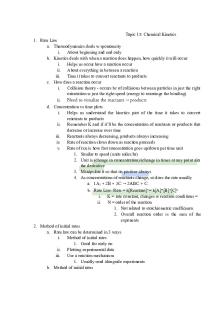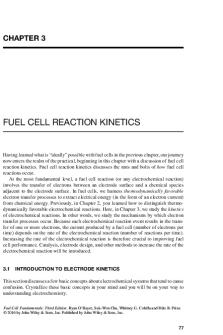Kinetics definition - defintion PDF

| Title | Kinetics definition - defintion |
|---|---|
| Author | Kenny Lam |
| Course | Chemistry of the Living World |
| Institution | University of Auckland |
| Pages | 3 |
| File Size | 85.5 KB |
| File Type | |
| Total Downloads | 99 |
| Total Views | 125 |
Summary
defintion...
Description
Kinetics definition Average rate The average rate is the change in rate over a time interval
Instantaneous rate Instantaneous rate is the rate at a specific point in time during the course of the reaction
Rate law Relationship between rate and concentration E.g. rate ∝ [A] / rate = k[A] Reaction rate The change in concentration of a reactant over time Rate constant Proportionality constant (k) in rate law E.g. for a 1st order reaction: rate =k[conc] First order reaction Where the overall reaction order in the rate law is one reaction Rate ∝ [A] Third order reaction Where the overall reaction order in the rate law is three The rate is 3rd order in as single reactant or 2nd order in one and 1st order in another or 1st order in each of three reactants Rate ∝ [A]3 / rate ∝ [A]2[B] / rate ∝ [A][B][C]
Half life Time taken for concentration of reactant to fall to half its initial value E.g. for a 1st order reaction t1/2 = In2/k Activation energy Activation energy (Ea) is the energy required by the reactants to reach the transition state Reaction profile A graph showing the reaction pathway/reaction coordinates versus energy Boltzmann distribution The distribution that temperature is proportional to average molecule energy Reaction mechanism The overall sequence of steps Rate determining step Overall reaction rate depends on the rate of the slowest step Reactive intermediate Represent points of minimum energy on the overall reaction Transition state The transition state in an elementary reaction is the point of highest energy between reactants and products Catalyst Catalyst are substances that speed up a reaction without being consumed in the overall process Homogeneous catalyst (usually appear in rate law) Catalyst that work in the same phase as the reaction Heterogeneous catalyst A heterogeneous catalyst is in a different phase to the reactants E.g. Pt(solid) in the hydrogenation of alkenes(gas) Arrhenius equation Arrhenius equation gives the relationship for the temperature dependence of the reaction rate constant k = Ae-Ea/RT Uncatalyzed Reaction 1 has lower activation energy Rhodium catalyst
Reaction 1 unchanged, but reaction 2 has a new low energy pathway
Reaction mechanism A series of elementary step Rate limiting step One of these steps determines the rate of reaction...
Similar Free PDFs

Kinetics definition - defintion
- 3 Pages

Kinetics Questions
- 21 Pages

Definition
- 12 Pages

Kinetics lab
- 3 Pages

Angular Kinetics
- 1 Pages

Topic 15 Chemical Kinetics
- 5 Pages

Kinetics Practice Problems
- 15 Pages

Linear Kinetics (Biomechanics)
- 1 Pages

Enzyme Kinetics Lab Simulation
- 4 Pages

Enzyme Kinetics Lab Report
- 14 Pages

Lecture Notes 1 Kinetics
- 32 Pages

Kinetics Pre Lab
- 2 Pages

FUEL CELL REACTION KINETICS
- 40 Pages
Popular Institutions
- Tinajero National High School - Annex
- Politeknik Caltex Riau
- Yokohama City University
- SGT University
- University of Al-Qadisiyah
- Divine Word College of Vigan
- Techniek College Rotterdam
- Universidade de Santiago
- Universiti Teknologi MARA Cawangan Johor Kampus Pasir Gudang
- Poltekkes Kemenkes Yogyakarta
- Baguio City National High School
- Colegio san marcos
- preparatoria uno
- Centro de Bachillerato Tecnológico Industrial y de Servicios No. 107
- Dalian Maritime University
- Quang Trung Secondary School
- Colegio Tecnológico en Informática
- Corporación Regional de Educación Superior
- Grupo CEDVA
- Dar Al Uloom University
- Centro de Estudios Preuniversitarios de la Universidad Nacional de Ingeniería
- 上智大学
- Aakash International School, Nuna Majara
- San Felipe Neri Catholic School
- Kang Chiao International School - New Taipei City
- Misamis Occidental National High School
- Institución Educativa Escuela Normal Juan Ladrilleros
- Kolehiyo ng Pantukan
- Batanes State College
- Instituto Continental
- Sekolah Menengah Kejuruan Kesehatan Kaltara (Tarakan)
- Colegio de La Inmaculada Concepcion - Cebu


